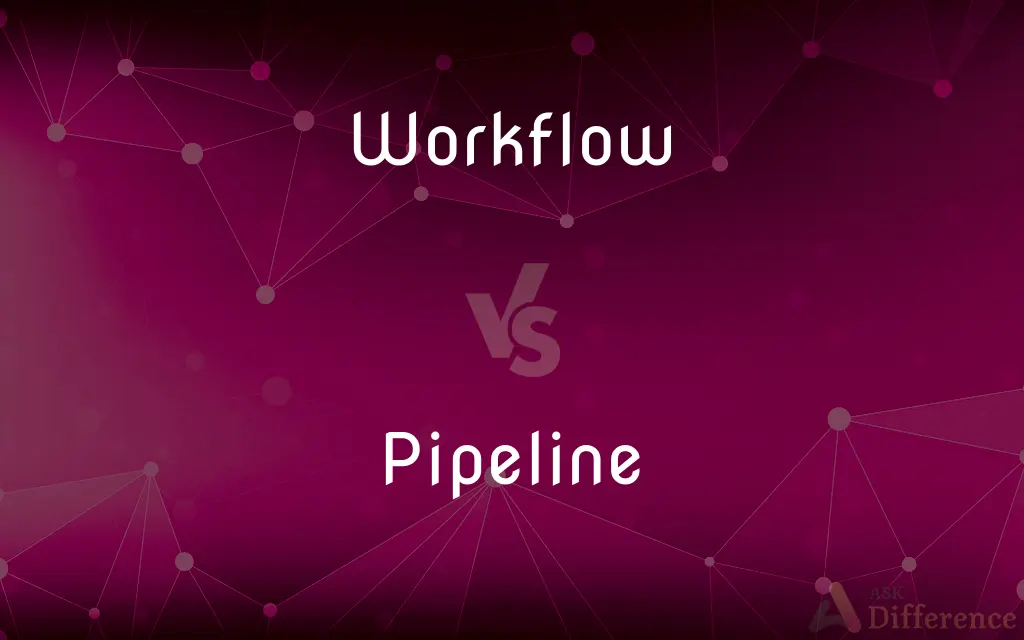Workflow vs. Pipeline — What's the Difference?
By Urooj Arif & Fiza Rafique — Updated on March 26, 2024
Workflow involves a sequence of tasks designed to achieve a specific outcome, focusing on process and task management. Pipeline is series of automated processes, in software development, emphasizing flowof data or tasks through various stages.

Difference Between Workflow and Pipeline
Table of Contents
ADVERTISEMENT
Key Differences
Workflows are structured sequences of tasks and activities aimed at accomplishing a particular goal or project. They emphasize the organization of work, including the order of tasks, the roles responsible for each task, and the rules that govern the process. On the other hand, pipelines refer specifically to a set of automated processes designed to execute tasks in a sequence, where the output of one task serves as the input for the next. Pipelines are commonly associated with software development, data processing, and continuous integration/continuous deployment (CI/CD) practices, where they automate the flow of code or data through stages such as testing, building, and deployment.
Workflows are adaptable to a broad range of contexts and emphasize task management, process efficiency, and the integration of work across teams and departments. They are crucial for project management, business operations, and administrative processes, providing a framework that guides how work is done, from initiation to completion. Conversely, pipelines are more technical and focused on automating and optimizing the flow of data or code. They are crucial in environments where speed, efficiency, and accuracy in processing large volumes of data or managing complex software deployments are required.
While workflows might involve human intervention at various stages, for review or decision-making, pipelines strive to minimize human intervention to increase speed and reduce the risk of errors. The concept of a pipeline is built around the idea of automating repetitive tasks and ensuring a smooth, uninterrupted flow of data or software from development to production.
Both workflows and pipelines are designed to improve efficiency and effectiveness but differ in their application and focus. Workflows are broader in scope, applicable in various industries for managing processes and tasks, whereas pipelines are more specific to fields that benefit from automation, such as software development and data science. Understanding the distinction is key to applying each concept effectively in its respective domain.
Despite their differences, workflows and pipelines share the objective of streamlining processes to achieve specific goals. In the digital age, the lines between them can blur, especially in industries where automation and technology play a significant role in workflows. The integration of automated pipelines within broader workflow processes represents the convergence of these concepts, showcasing the evolution of task and process management in response to technological advancements.
ADVERTISEMENT
Comparison Chart
Definition
A sequence of tasks designed to achieve a specific outcome, focusing on process management.
A series of automated processes for executing tasks in sequence, emphasizing data or code flow.
Focus
Process and task management.
Automation and efficiency in technical processes.
Application
Broad, across various industries for managing work processes.
Typically technical fields like software development and data processing.
Human Intervention
Can involve manual tasks and decision points.
Minimizes human intervention for increased efficiency.
Objective
To streamline operations and enhance efficiency through organized task management.
To automate the flow of data or tasks, optimizing speed and accuracy.
Compare with Definitions
Workflow
Involves task organization and roles.
Their workflow specifies each department's responsibilities in the product development cycle.
Pipeline
Automated process sequence.
Their software development pipeline includes automated testing and deployment.
Workflow
Structured process management.
The company implemented a new workflow to improve project delivery times.
Pipeline
Minimizes human intervention.
By using a deployment pipeline, they significantly reduced release errors.
Workflow
Sequence of tasks for specific outcomes.
The marketing team followed a detailed workflow for their campaign launch.
Pipeline
Optimizes technical processes.
Integrating an analytics pipeline has streamlined their data analysis phase.
Workflow
Can be manual or automated.
Automating part of the sales workflow reduced manual data entry.
Pipeline
Focuses on data or code flow.
The data pipeline processes and analyzes customer feedback in real time.
Workflow
Used across various industries.
Healthcare providers use workflows to manage patient care efficiently.
Pipeline
Common in technical fields.
The team improved their CI/CD pipeline for faster software releases.
Workflow
A workflow consists of an orchestrated and repeatable pattern of activity, enabled by the systematic organization of resources into processes that transform materials, provide services, or process information. It can be depicted as a sequence of operations, the work of a person or group, the work of an organization of staff, or one or more simple or complex mechanisms.
Pipeline
A long pipe, especially one used for the conveyance of water, gas, or petroleum products.
Workflow
The flow or progress of work done by a company, industry, department, or person.
Pipeline
A channel by which information is privately transmitted.
Workflow
The rate at which such flow or progress takes place.
Pipeline
A system through which something is conducted, especially as a means of supply
"Farther down the pipeline are three other approaches to vaccine development" (Boston Globe).
Workflow
The rate at which a flow of work takes place
Pipeline
To convey by or as if by a system of pipes.
Workflow
(business) A process or procedure by which tasks are completed. It may be defined by a flowchart with actors, actions, results, decisions, and action paths.
Pipeline
To lay a system of pipes through.
Workflow
Progress (or rate of progress) in work being done
Pipeline
A conduit made of pipes used to convey water, gas or petroleum etc.
An oil pipeline has been opened from the Caspian Sea.
Pipeline
A channel (either physical or logical) by which information is transmitted sequentially (that is, the first information in is the first information out).
3D images are rendered using the graphics pipeline.
Pipeline
(figurative) A system or process through which something is conducted.
A new version of the software is in the pipeline, but has not been rolled out.
Pipeline
(surfing) The inside of a wave that a surfer is riding, when the wave has started closing over it.
Pipeline
To design (a microchip etc.) so that processing takes place in efficient stages, the output of each stage being fed as input to the next.
Pipeline
(transitive) To convey something by a system of pipes
Pipeline
(transitive) To lay a system of pipes through something
Pipeline
To connect a tube from ones mouth to ones anus (or the anus of another), in order to force someone to eat feces.
Pipeline
A line of pipe with pumping machinery and apparatus for conveying liquids, gases, or finely divided solids, such as petroleum or natural gas, between distant points.
Pipeline
Fig. an information channel direct from the source.
Pipeline
The set of stages and processes from the invention or design of a product to its ultimate use, production, or commercial sale. Used commonly in the phrase in the pipeline, i. e. still in preparation or under development.
Pipeline
Gossip spread by spoken communication;
The news of their affair was spread by word of mouth
Pipeline
A pipe used to transport liquids or gases;
A pipeline runs from the wells to the seaport
Common Curiosities
Why are pipelines important in software development?
Pipelines automate the software development process, including testing, building, and deployment, reducing errors and improving release speed.
Can a workflow include a pipeline?
Yes, a workflow can include a pipeline as part of its sequence, especially in contexts where automated processes enhance efficiency and accuracy.
What is a workflow?
A workflow is a structured sequence of tasks designed to achieve a specific outcome, focusing on process and task management.
How does human intervention differ between workflows and pipelines?
Workflows may require human intervention for decision-making and manual tasks, whereas pipelines aim to minimize human involvement to increase efficiency.
How do workflows and pipelines differ in application?
Workflows are broadly applied across various industries for process management, while pipelines are specific to technical fields requiring automated process sequences.
How does automation impact workflows and pipelines?
Automation streamlines both workflows and pipelines, enhancing efficiency, reducing errors, and allowing for scalability in processes.
What is a pipeline?
A pipeline refers to a series of automated processes for executing tasks in sequence, often used in software development and data processing to optimize efficiency.
Can pipelines be part of a non-technical workflow?
While pipelines are typically associated with technical processes, their principles can be applied to automate repetitive tasks in non-technical workflows as well.
Are all pipelines automated?
Yes, the concept of a pipeline in the context discussed refers to automated sequences of processes designed to execute tasks without manual intervention.
How can a business implement workflows effectively?
Effective workflow implementation involves clear task organization, defining roles and responsibilities, and integrating appropriate tools for process management.
How do workflows enhance business operations?
Workflows organize tasks, define roles, and streamline processes, enhancing efficiency, consistency, and productivity in business operations.
What role do pipelines play in data processing?
In data processing, pipelines automate the flow of data through various stages, from collection to analysis, optimizing speed and accuracy.
Can the efficiency of a workflow or pipeline be measured?
Yes, the efficiency of workflows and pipelines can be measured through metrics such as completion times, error rates, and overall process improvement.
What challenges might arise when implementing pipelines within workflows?
Challenges include integrating technology tools, ensuring seamless data flow, and managing changes in processes without disrupting ongoing operations.
What technologies are commonly used in building pipelines?
Technologies used in building pipelines include CI/CD tools, data processing frameworks, and automation software.
Share Your Discovery

Previous Comparison
Podocarpus vs. Taxus
Next Comparison
Biaxial vs. CoaxialAuthor Spotlight
Written by
Urooj ArifUrooj is a skilled content writer at Ask Difference, known for her exceptional ability to simplify complex topics into engaging and informative content. With a passion for research and a flair for clear, concise writing, she consistently delivers articles that resonate with our diverse audience.
Co-written by
Fiza RafiqueFiza Rafique is a skilled content writer at AskDifference.com, where she meticulously refines and enhances written pieces. Drawing from her vast editorial expertise, Fiza ensures clarity, accuracy, and precision in every article. Passionate about language, she continually seeks to elevate the quality of content for readers worldwide.














































